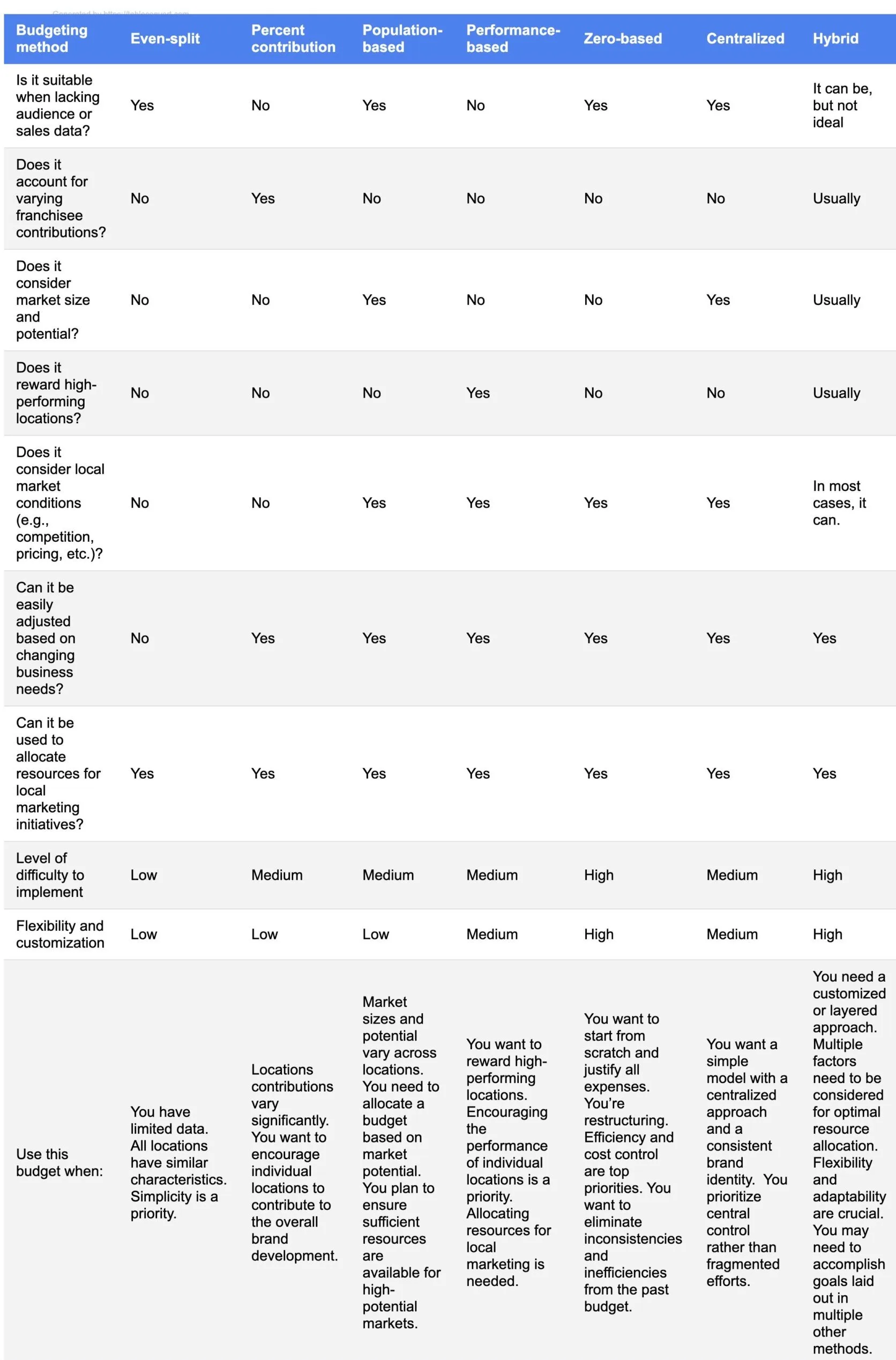7 location-based budgeting strategies to optimize spending

In today’s dynamic market environment, a custom budgeting approach is essential. There’s no room for a one-size-fits-all approach to budgeting. What works for one company might not be optimal for another—especially when you’re dealing with multiple locations, each with varying sizes, target demographics, and local market conditions.
The trick is choosing the most suitable location-based budgeting strategy—one that’s as flexible as it is powerful, one that can adapt to the unique rhythms of your business. Explore the following seven strategies, along with the pros and cons of each, to help you decide which will fit your business best.
7 types of location-based budgeting strategies
There are several budgeting models, each with its advantages and considerations. The choice ultimately depends on factors like the availability of audience and sales data, the level of contribution from individual locations, and the overall financial goals of the enterprise. Let’s dive in to explore some of the most common types of location-based budgeting strategies.
1. Even-split budgeting
Even-split budgeting is a straightforward approach where the total marketing budget is divided equally among all business or franchise locations. This traditional budgeting method is beneficial when you don’t have detailed audience or sales data for each location, as it ensures a fair distribution of resources across the board.
To implement even-split budgeting, start by determining the total marketing budget for the enterprise. Then, divide this amount by the number of locations to arrive at the budget allocation for each unit. For example, if you have a total marketing budget of $1 million and 100 locations, each location would receive $10,000 for their marketing efforts.
Pros
Even-split budgeting is easy to understand and implement, making it a good choice for businesses just starting out or with limited data. It also promotes fairness and equality to make sure that each location receives the same level of support.
Cons
This method doesn’t take into account the unique characteristics and needs of each location. Franchises or locations in highly competitive markets or those with large customer bases may require more resources to be effective, while those in smaller markets may not need as much. Additionally, even-split budgeting doesn’t consider the individual performance of each location, which could lead to inefficiencies in resource allocation.
2. Percent marketing contribution budgeting
Percent contribution budgeting allocates marketing funds based on the percentage each location contributes to the overall marketing budget. This method is suitable when the individual locations contribute different amounts to the collective marketing fund, as it ensures that the allocation of the budget is proportional to each location’s investment.
Corporate first determines the overall marketing budget amount, factoring in contributions from all locations as well as any additional funds they allocate.
Each location then receives a percentage of this finalized total marketing budget that is proportional to their individual contribution.
To apply percent contribution budgeting, first determine the total amount contributed by all local divisions to the marketing budget. Then, calculate the percentage that each location contributes to this total. Finally, the marketing budget for each location should be allocated based on their individual contribution percentage.
Let’s say the total contributions to the budget from all locations is $5 million and franchise A contributed $250,000, so their contribution would be:
$250,000 / $5,000,000 = 5% of the total marketing budget.
If the corporate office sets a $8 million total marketing budget for the coming year, franchise A would receive 5% of the $8 million (or $400,000) as their allocated marketing budget for that year.
So even though franchise A’s actual contribution was $250,000, since that made up 5% of the total $5 million contributed by all locations, they receive 5% of whatever the final overall marketing budget amount is set at by the corporate office, in this case $400,000 out of the $8 million budget.
Pros
This method is equitable, ensuring that divisions who contribute more to the marketing budget also receive a larger share of the resources. It can also incentivize all locations to focus more on marketing, as they know that their contributions will directly impact the level of support they receive.
The percent contribution approach is useful whether corporate handles the overall marketing for each location or whether regional marketing directors guide the marketing spend decisions for the locations in their territory.
Cons
Percent contribution budgeting may not account for the varying needs of different locations. A store in a highly competitive market may require more marketing support, even if their contribution to the budget is lower. Additionally, this method relies on accurate tracking of contributions from each store, which can be challenging when creating a financial plan.
3. Performance-based budgeting
Performance-based budgeting allocates marketing resources based on the historical data of each location. This method rewards high-performing locations with additional support and provides targeted assistance to those struggling.
While this model is similar to percent contribution budgeting, it doesn’t just focus on the monetary contribution to the marketing fund. Performance-based budgeting takes a flexible approach to allocate funds based on a few chosen outcomes achieved by each location—which could be ROI, sales growth, conversion rates, gross sales, etc.
To apply performance-based budgeting:
- Establish clear performance metrics for each location, such as sales growth, customer acquisition rates, or marketing ROI.
- Track the impact of online advertisements that lead to offline conversions.
- Use tools like Yelp Store Visits to get a proper metric on the number of people who walked into a store after viewing an online ad.
- Rank locations based on their performance and allocate the marketing budget accordingly.
High-performing locations may receive a larger share of the budget to fuel further growth, while underperforming locations may receive support for specific initiatives to improve their results.
For example, if an enterprise had a $1 million marketing budget and 10 locations, with Location A achieving 25% sales growth and Location B just 5% growth, the enterprise could allocate $200,000 to Location A but only $50,000 to Location B.
Pros
Performance-based budgeting aligns marketing investments with the actual results achieved by each location. This way, funds can be directed toward locations that have shown a high level of potential for generating returns. It can also create a competitive incentive for other locations to optimize their marketing efforts and strive for better performance.
Cons
This method requires robust data collection and analysis to accurately assess each location’s performance. It may also create tension among locations if the budgeting process is not transparent or the performance metrics are perceived as unfair. Additionally, focusing solely on past performance may not account for changes in market conditions or new opportunities that could impact future results.
4. Population-based budgeting
Population-based budgeting distributes marketing funds based on the population size of each location’s target market. This approach recognizes that locations serving larger populations may require more resources to effectively reach their audience.
To implement population-based budgeting:
- Start by determining the total population of target customers across all local markets
- Calculate the percentage of that total population that each location serves
- Allocate the marketing budget to each location based on their population percentage
For example, if a franchise of a national retail chain serves 10% of the total target audience across the country, they would receive 10% of the total marketing budget.
Pros
Population-based budgeting takes into account the potential audience size of each location, ensuring that resources are allocated in proportion to the market opportunity. This can lead to more effective marketing spend, as locations with larger populations may require more frequent or extensive campaigns to reach their audience.
Cons
This method doesn’t consider other factors that may impact the outcome of marketing initiatives, such as competition, local media costs, or the socioeconomic characteristics of the population. It also doesn’t account for the individual performance or contribution of each location.
5. Zero-based budgeting

Zero-based budgeting requires organizations to create their new budget plan from scratch each year, justifying every expenditure rather than basing it on the previous year’s budget.
To apply zero-based budgeting in marketing, start by looking at your finances with a fresh set of eyes every year and define clear objectives and KPIs for each marketing initiative. Then, evaluate the potential ROI of each proposed campaign or activity, prioritizing those with the highest expected impact.
Allocate funds to the initiatives that align best with your long-term goals and have the strongest case to maximize ROI. Regularly monitor and adjust the annual budget based on actual performance data to ensure that resources are used effectively.
Pros
Zero-based budgeting encourages a thorough evaluation of all marketing expenses, helping to identify and eliminate inefficiencies and consider unexpected expenses before creating a strategic plan for the next year. It also ensures that marketing investments are aligned with current strategic priorities rather than simply continuing past practices.
Cons
This approach can be time-consuming and resource-intensive, requiring a comprehensive review of all marketing activities in each budgeting cycle. It may also be challenging to accurately predict the ROI of new or untested initiatives, leading to the potential underfunding of promising opportunities or overfunding bad forecasts.
6. Centralized budgeting
In a centralized budgeting approach, the corporate office creates and controls the marketing budget for all locations. The corporate team determines the total budget and how funds should be allocated across the different units based on factors like:
- Overall marketing objectives and KPIs for the enterprise
- Analysis of past marketing performance data across locations
- Projected customer demand and growth opportunities in different markets
- Competitive landscape and strategic priorities for each market
A common strategy used is the sales potential method, where budget allocations are made proportional to the forecasted sales or revenue potential of each location or market. Locations with higher projected sales get a higher percentage of the total marketing budget.
Such a top-down strategy streamlines the budgeting process and ensures consistency in marketing spend across the enterprise. Oftentimes, this means one budget that is optimized by specific platform tools to bring the most results across the enterprise, regardless of location.
Pros
The centralized model allows for better oversight and control. It can leverage economies of scale for things like media buying and provide effective results.
Cons
This approach may not adequately account for the unique needs and circumstances of individual locations, as some may feel that the budgeting process is inflexible and disconnected from local market realities. There is also a risk of some locations having less autonomy and ownership over their marketing efforts, which could impact engagement and buy-in.
7. Hybrid budgeting
Hybrid budgeting combines elements of different budgeting methods to create a customized approach that meets the specific needs of the franchise system. This method allows for flexibility and adaptability in allocating marketing resources.
For example, multi-location businesses with a solid online presence often allocate a significant portion of their marketing budget to digital channels. These funds can be managed centrally to ensure a cohesive online brand experience and to optimize digital campaigns across all markets.
While digital marketing is typically managed centrally, businesses may also allocate funds to regional divisions to target specific geographic regions or customer segments using in-person marketing tactics.
To implement hybrid budgeting, identify the key factors influencing budget allocation, such as location performance, market potential, franchisee contributions, and your brand’s specific goals. Then develop a custom approach that weighs these factors according to their importance, and use it to determine the budget allocation for each location.
Pros
Hybrid budgeting allows franchise systems to tailor their budgeting approach to their unique circumstances and priorities while also providing equitable support with a cohesive message. By considering multiple factors, this method can provide a more comprehensive and balanced allocation of resources. It also offers the flexibility to adjust the formula over time as the franchise system evolves and new data becomes available.
Cons
Developing and implementing a hybrid budgeting system can be time-consuming, as it requires careful consideration of multiple variables and the creation of a customized formula. It needs to be carefully explained to locations, as the allocation process may not be as straightforward as other methods.
Comparison between different budgeting methods for multi-location businesses

Creating an adaptable budgeting strategy: 5 key points to consider
Choosing from so many location-based budgeting strategies can be difficult, so here are a few things to keep in mind to help you identify the best ones for your enterprise.
1. Incorporate regional differences into budget models
When adopting a budget model—such as the zero-based budgeting, centralized budgeting, even-split, or the percent contribution budgeting approach—consider adjusting the budget allocations based on regional differences you’ve identified through market research.
These differentiating factors could be customer demographics, purchasing behaviors, and media consumption habits. This helps the budget model more accurately reflect each market’s unique characteristics and needs, enabling more targeted and effective resource allocation.
For example, if your market research reveals that your potential customers in a particular region prefer mobile-first experiences, allocate a larger portion of the marketing budget for that location to mobile advertising and optimizing the mobile user experience.
Similarly, if a specific location has a higher concentration of a particular demographic group, tailor your marketing messages and channels to resonate with that audience and adjust your budget accordingly.
2. Adapt your budgeting approach based on market fluctuations
As market conditions evolve, adapting your location-based budgeting strategies to reflect these changes is crucial. Regularly review and update your location-based budgeting strategies depending on shifts in consumer behavior, competitive landscape, and economic factors specific to each location. By incorporating flexibility into your location-based budgeting strategies, such as rolling or flexible budgets, you can quickly adjust resource allocations to capitalize on emerging opportunities or mitigate risks in each market.
Establish a process for regularly monitoring and analyzing market trends to stay agile and responsive to market changes. Stay informed about local events, economic conditions, and emerging trends that may impact your business through online trends monitoring, industry publications, and social media listening. Encourage local managers and franchisees to provide regular feedback on market conditions and customer preferences, as they deeply understand their specific locations.
Regardless of your budgeting type, decision-makers—centralized marketing leaders or regional managers—should be cautious of their spending patterns and have some money set aside for the emergency fund in times of economic uncertainty.
3. Align location-specific priorities with the overall brand strategy
When allocating budget for multiple locations, ensure that these decisions align with the company’s overall budgeting and brand strategy. This will ensure that resources are allocated in a way that supports both regional and company-wide objectives.
To do this, involve key stakeholders from both corporate and local levels in the budgeting process. Encourage open communication and collaboration between corporate finance teams, marketing departments, and local managers to ensure that everyone is working toward the same strategic goals. Clearly communicate the company’s overall strategic objectives and long-term goals to all stakeholders and help them understand how their location-specific priorities contribute to the bigger picture. Keep an open channel for the regional managers to come back to you with feedback, suggestions, and assistance.
Be sure to balance location-specific needs and overall company goals, ensuring that resources are not disproportionately allocated to any one location at the expense of others.
4. Earmark funds in the budget for brand consistency and development
In the complex task of marketing budget allocation, a central focus on brand consistency is essential for success. You can do this by establishing a centralized brand management budget, which is dedicated to creating and maintaining brand guidelines, asset management, and implementing comprehensive brand audits. This budget serves as the foundation for consistent brand representation across all markets.
Invest in a comprehensive digital asset management (DAM)—like Adobe Experience Manager or Bynder—that is a central hub for planning, executing, and tracking all multi-location marketing activities, campaigns, and budgets across locations, enabling visibility and control over brand compliance.
It’s also important to set aside a specific portion of the budget for brand monitoring tools like BuzzSumo or Brandwatch to make data-driven adjustments to future budgeting and brand strategies. You’ll also need a brand innovation fund within the central budget to test new brand experiences and technologies, ensuring the brand remains dynamic and resonates with diverse market segments while upholding core brand values.
5. Continuously track and refine your budget through data analytics

Data analytics tools can provide valuable insights into each location’s performance, allowing you to refine your location-based budgeting strategies according to actual data. Such insights are crucial when you opt for a performance-based or percent contribution budgeting model.
In fact, you can also choose a budgeting approach for your enterprise based on the type of metrics available and the outcomes you want to track.
Analyze each location’s website traffic, engagement rates, and conversion data to identify patterns and preferences. Conduct surveys or focus groups with customers in different regions to gain insights into their needs, preferences, and pain points. Use this information to create buyer personas specific to each location, which can inform your budgeting decisions and help you allocate resources more effectively.
Use tools that offer budget management and performance tracking capabilities, like Uptempto or Proof Analytics. Such tools can help streamline collaboration and provide a clear view of marketing effectiveness, making them a cornerstone for maintaining brand consistency while keeping an eye on your budget.
Integrate location-specific metrics, such as sales revenue, CAC, LTV, and marketing ROI, into your budgeting process to identify high-performing locations and allocate resources accordingly. Use this data to streamline your decision-making process when adjusting budget models, such as increasing allocations for successful locations or reallocating funds to help improve underperforming areas.
Optimize resource allocation the smart way
As the marketplace evolves, so must your approach to marketing budget allocation. The multi-location business model demands not just agility but a nuanced understanding of the broader brand goals as well as the factors that contribute to regional success.
Get down at the grassroots level to understand the local factors and guide the regional teams to align their efforts with the overall brand strategy. Consider your brand’s unique requirements, target demographics, and other external and internal factors as you choose and allocate the marketing budget.
Let the metrics guide you to make the best decision for your enterprise. To know the exact metrics to track, use this cheat sheet for tracking analytics in multi-location marketing.